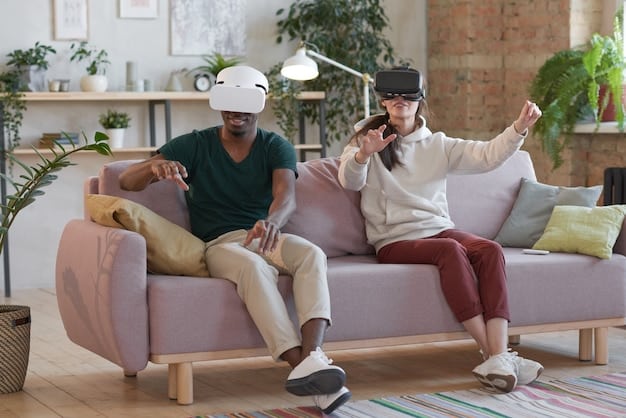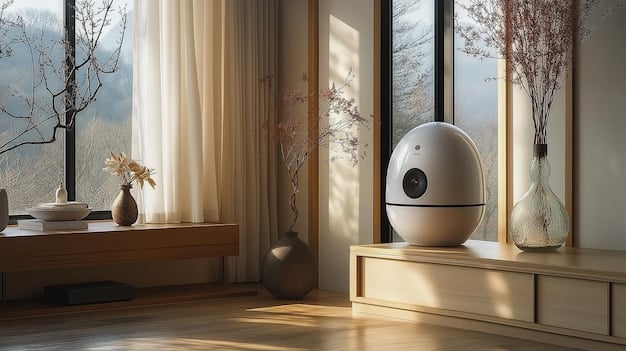Metaverse & Smart Homes: Will VR Be Commonplace by 2027?

The integration of the metaverse into smart homes promises immersive experiences, enhanced automation, and personalized environments, potentially becoming commonplace by 2027 as technology advances and adoption rates increase in the USA.
Imagine controlling your home’s lighting with a flick of your wrist in a virtual interface, or attending a meeting in a photorealistic recreation of your living room. The Impact of the Metaverse on Smart Homes: Will Virtual Reality Integration Become Commonplace by 2027? is a question that is gaining prominence as technology advances.
Understanding the Metaverse and Its Potential
The metaverse, a term once confined to science fiction, is rapidly becoming a tangible reality. Understanding what it is and its vast potential is crucial before exploring its impact on smart homes.
The metaverse is a persistent, shared, 3D virtual world (or worlds) that is interactive, immersive, and collaborative. It is often envisioned as the future of the internet, blending the physical and digital realms seamlessly. This integration allows users to engage in various activities, from socializing and gaming to working and learning, all within a virtual environment.
Key Characteristics of the Metaverse
To fully grasp the metaverse’s potential, it’s important to understand its key characteristics. These features differentiate it from traditional online experiences and highlight its transformative capabilities.
- Immersion: The metaverse provides immersive experiences that make users feel present in the virtual world through technologies like VR and AR.
- Interactivity: Users can interact with the environment and other participants in real-time, creating dynamic and engaging experiences.
- Persistence: The metaverse exists continuously, even when users are not actively participating, maintaining a consistent and evolving environment.
- Socialization: The metaverse facilitates social interactions, allowing users to connect, collaborate, and build communities within virtual spaces.
The metaverse is not just a single technology; it’s a convergence of multiple technologies, including virtual reality (VR), augmented reality (AR), blockchain, artificial intelligence (AI), and 3D modeling. These technologies work together to create rich, interactive, and persistent virtual environments.
In conclusion, the metaverse represents a significant shift in how we interact with technology and each other. Its immersive, interactive, and persistent nature unlocks a multitude of possibilities, making it a key area of interest for various industries, including the smart home sector.

Current State of Smart Home Technology
Smart home technology has already revolutionized how we interact with our living spaces. It’s essential to understand the current landscape to appreciate the potential impact of the metaverse.
Smart homes utilize interconnected devices and systems to automate tasks, enhance convenience, and improve energy efficiency. These systems often include smart lighting, thermostats, security cameras, entertainment systems, and appliances, all controlled through a central hub or mobile app.
Popular Smart Home Devices and Systems
The smart home market is filled with a diverse range of devices and systems designed to cater to different needs and preferences. Here are some of the most popular options:
- Smart Speakers: Devices like Amazon Echo and Google Home act as central hubs, allowing voice control over other smart home devices.
- Smart Lighting: Systems like Philips Hue enable automated lighting schedules and customizable lighting scenes to enhance ambiance and energy efficiency.
- Smart Thermostats: Devices like Nest Learning Thermostat learn user preferences to optimize temperature settings and reduce energy consumption.
While current smart home technology offers significant convenience and automation, it often lacks the immersive and interactive experiences that the metaverse can provide. Integrating the metaverse could bridge this gap, creating a more engaging and personalized smart home environment.
To conclude, smart home technology has made considerable advancements, offering increased convenience and efficiency. By integrating with the metaverse, we can look forward to a more immersive and interactive future for our living spaces.
How the Metaverse Can Enhance Smart Homes
The integration of the metaverse with smart homes has the potential to revolutionize the way we interact with our living spaces. Let’s look at how this synergy can enhance our homes.
The metaverse can transform smart homes by providing immersive interfaces for controlling devices, creating virtual replicas of homes for remote management, and enabling personalized virtual environments that adapt to individual preferences. This integration can lead to more intuitive, efficient, and enjoyable smart home experiences.
Immersive Control Interfaces
Traditional smart home control methods, such as mobile apps and voice commands, can be limiting. The metaverse offers the potential for immersive control interfaces that provide a more intuitive and engaging way to manage smart home devices.
- Virtual Dashboards: Users can interact with virtual dashboards to monitor and control various aspects of their home, such as lighting, temperature, and security, in a 3D environment.
- Gesture Control: Using VR/AR technology, users can control devices with natural gestures, like pointing to turn on a light or swiping to adjust the thermostat.
- Gamified Control: Gamification elements can be incorporated into the smart home control interface, making it more engaging and fun to manage home devices.
By leveraging the metaverse, smart home control can become more natural, intuitive, and enjoyable, enhancing the overall user experience.
In summary, the metaverse has the potential to transform smart homes into personalized interactive environments that seamlessly blend physical and virtual worlds.
Challenges and Opportunities of Metaverse Integration
While the integration of the metaverse into smart homes presents numerous opportunities, it also poses significant challenges that need to be addressed.
These challenges include technological limitations, security and privacy concerns, and the need for standardization and interoperability. Overcoming these challenges will be critical to realizing the full potential of metaverse-integrated smart homes.
Technological Limitations
Current VR/AR technology still faces limitations in terms of usability and accessibility, such as high hardware costs, discomfort during prolonged use, and limited field of view. These limitations can hinder the widespread adoption of metaverse-integrated smart homes.
Overcoming these technological hurdles will require advancements in hardware design, software development, and network infrastructure. As technology improves, the metaverse will become more accessible and user-friendly.
Security and Privacy Concerns
As smart homes become more interconnected and integrated with the metaverse, the risk of security breaches and privacy violations increases. Protecting user data and ensuring the security of smart home systems will be paramount.
Addressing these concerns will require robust security measures, such as encryption, multi-factor authentication, and regular security audits. Additionally, privacy regulations and ethical guidelines will need to be established to govern the collection and use of user data in metaverse-integrated smart homes.

Opportunities for Innovation
Despite the challenges, the integration of the metaverse into smart homes presents numerous opportunities for innovation. These opportunities span various areas, from hardware and software development to content creation and service provision.
In conclusion, although there are challenges that need to be addressed, the innovative potential of integrating the metaverse into smart homes is substantial.
Potential Use Cases for Metaverse Smart Homes
The integration of the metaverse into smart homes could unlock various innovative use cases that enhance convenience, entertainment, and productivity.
These use cases range from virtual home tours and remote collaboration to personalized entertainment experiences and immersive learning environments. Exploring these possibilities can help us envision the future of smart homes.
Virtual Home Tours and Real Estate
The metaverse can revolutionize the real estate industry by enabling virtual home tours that provide potential buyers with an immersive and interactive experience. Buyers can explore properties remotely, customize layouts and décor, and interact with virtual agents in a realistic 3D environment.
This can save time and resources for both buyers and sellers, reduce the need for physical visits, and expand the reach of real estate marketing.
Remote Collaboration and Workspaces
The metaverse can transform smart homes into immersive remote workspaces that enhance collaboration and productivity. Users can create virtual offices that replicate their physical workspaces, interact with colleagues in realistic 3D environments, and collaborate on projects in real-time using shared virtual tools.
This can improve communication, foster teamwork, and reduce the need for physical office spaces.
Metaverse-integrated smart homes can provide personalized entertainment experiences that cater to individual preferences. Users can create virtual theaters to watch movies with friends, attend virtual concerts and events, and play immersive games using smart home devices as controllers.
This can enhance the entertainment value of smart homes and create new opportunities for content creators and service providers.
Future Predictions: Metaverse Smart Homes by 2027
Predicting the future is always challenging, but analyzing current trends and technological advancements can provide insights into what metaverse-integrated smart homes might look like by 2027.
By 2027, it’s likely that VR/AR technology will have become more affordable, user-friendly, and integrated into everyday life. This will drive the adoption of metaverse-integrated smart homes.
Increased Adoption of VR/AR Technology
As VR/AR technology becomes more accessible and user-friendly, more households will adopt these devices for entertainment, communication, and productivity. This will create a larger user base for metaverse-integrated smart homes.
Furthermore, advances in wireless technology and network infrastructure will enable seamless and reliable connectivity for VR/AR devices, enhancing the user experience.
Development of Standardized Platforms and Protocols
To ensure interoperability and compatibility between different smart home devices and metaverse platforms, standardized protocols and platforms will need to be developed. This will enable seamless integration and data sharing between various systems.
- Open Standards: Industry collaborations and open-source initiatives will drive the development of open standards for metaverse-integrated smart homes.
- Interoperability Testing: Rigorous testing and certification programs will ensure that devices and platforms comply with established standards.
- Cross-Platform Support: Developers will prioritize cross-platform support to maximize the reach and accessibility of metaverse-integrated smart home solutions.
Smart homes can become more adaptable and personalized through the integration of AI and machine learning (ML).
To conclude, as VR/AR technology and AI advances, we can anticipate that metaverse-integrated smart homes will be more common by 2027.
| Key Point | Brief Description |
|---|---|
| 🏠 Immersive Control | Metaverse offers virtual dashboards for intuitive smart home management. |
| 🔒 Security | Enhanced security needed to protect interconnected smart homes and user data. |
| 💼 Remote Work | Metaverse transforms homes into immersive, collaborative workspaces. |
| 🚀 VR/AR Growth | Increased adoption of VR/AR tech drives metaverse smart home integration by 2027. |
FAQ
▼
The metaverse is a persistent, shared, 3D virtual world that is interactive, immersive, and collaborative, often considered the future of the internet.
▼
The metaverse provides immersive interfaces for controlling devices, virtual replicas for remote management, and personalized virtual environments, enhancing user experience.
▼
Challenges include technological limitations, security and privacy concerns, and the need for standardization and interoperability.
▼
Potential use cases include virtual home tours, remote collaboration, personalized entertainment, and immersive learning experiences.
▼
By 2027, increased adoption of VR/AR technology and the development of standardized platforms will likely make metaverse-integrated smart homes more common.
Conclusion
In conclusion, the integration of the metaverse into smart homes holds immense potential, promising personalized, interactive, and efficient living spaces. While challenges remain, ongoing technological advancements and growing adoption rates suggest that virtual reality integration will become increasingly commonplace by 2027, shaping the future of smart homes in the USA.





